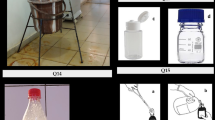Abstract
Purpose
In Japan, sterile water is used for rinsing in surgical handwashing, whereas in Western countries tap water is generally used. We conducted this study to examine the conditions and the equipment that affect bacterial contamination in tap water and to determine whether the tap water in our institute is suitable for surgical handwashing.
Methods
First, we examined the water pipes and measured the free chlorine content in the tap water in the operating room. Next, we recruited 40 volunteers and conducted preliminary tests with sterile water. Thirty of these subjects participated in a handwashing test using tap water.
Results
The mean free chlorine levels in the tap water and the sterile water were 0.30 ± 0.05 and 0.07 ± 0.03 mg/l, respectively. The handwashing test using tap water showed immediate, persistent, and cumulative bacteria activity within the minimum limits set by the Food and Drug Administration (FDA).
Conclusion
The free chlorine levels in the tap water in our institute satisfied Japanese health regulations. Moreover, the handwashing test met the criteria of the FDA. Thus, we conclude that this tap water is safe to use for rinsing in surgical handwashing.
Similar content being viewed by others
References
JS Heal AW Blom D Titcomb A Taylor K Bowker JR Hardy (2003) ArticleTitleBacterial contamination of surgical gloves by water droplets spilt after scrubbing J Hosp Infect 53 136–9 Occurrence Handle10.1053/jhin.2002.1352 Occurrence Handle1:STN:280:DC%2BD3s%2FnsFymsQ%3D%3D Occurrence Handle12586574
A Ferroni L Nguyen B Pron G Quesne MC Brusset P Berche (1998) ArticleTitleOutbreak of nosocomial urinary tract infections due to Pseudomonas aeruginosa in a paediatric surgical unit associated with tap-water contamination J Hosp Infect 39 301–7 Occurrence Handle10.1016/S0195-6701(98)90295-X Occurrence Handle1:STN:280:DyaK1cvitFansQ%3D%3D Occurrence Handle9749401
S Oie M Oomaki K Yorioka T Tatsumi M Amasaki T Fukuda et al. (1998) ArticleTitleMicrobial contamination of sterile water used in Japanese hospitals J Hosp Infect 38 61–5 Occurrence Handle10.1016/S0195-6701(98)90175-X Occurrence Handle1:STN:280:DyaK1c7nsVamtg%3D%3D Occurrence Handle9513069
M Tachikawa C Sayama K Saita M Tezuka R Sawamura (2002) ArticleTitleEffects of isocyanuric acid on the monochlorodimedone chlorinating rates with free chlorine and ammonia chloramines in water Water Res 36 2547–54 Occurrence Handle10.1016/S0043-1354(01)00482-1 Occurrence Handle1:CAS:528:DC%2BD38XktFaqt70%3D Occurrence Handle12153021
InstitutionalAuthorNameUS Food and Drug Administration (1994) ArticleTitleTentative Final Monograph for healthcare antiseptic drug products; proposed rule Fed Register 59 31441–52
InstitutionalAuthorNameASTM Standard 1115–91 (1996) ArticleTitleStandard test method for evaluation of surgical hand scrub formulations Annual book of ASTM standard 11 447–50
LJ Pereira GM Lee KJ Wade (1997) ArticleTitleAn evaluation of five protocols for surgical handwashing in relation to skin condition and microbial counts J Hosp Infect 36 49–65 Occurrence Handle10.1016/S0195-6701(97)90090-6 Occurrence Handle1:STN:280:ByiA3Mngslc%3D Occurrence Handle9172045
JM Boyce Pittet D (2002) ArticleTitleHealthcare Infection Control Practices Advisory Committee; HICPAC/SHEA/APIC/IDSA Hand Hygiene Task Force. Guideline for hand hygiene in health-care setting MMWR 50 1–45
SC Hsu R Martin BB Wentworth (1984) ArticleTitleIsolation of Legionella species from drinking water Appl Environ Microbiol 48 830–2 Occurrence Handle1:STN:280:BiqD2s7htFQ%3D Occurrence Handle6508292
S Uga T Oda K Kimura D Kimura S Koesdarto S Margono et al. (2003) ArticleTitleDetection of microorganisms in tap water in Indonesia and Thailand Jpn J Trop Med Hyg 31 87–91
U.S. Environmental Protection Agency. National Primary Drinking Water Regulations available from http://www.epa.gov/safewater/mcl.html#mcls
SR Palmer PR Gully JM White AD Pearson WG Suckling DM Jones et al. (1983) ArticleTitleWater-borne outbreak of campylobacter gastroenteritis Lancet 1 287–90 Occurrence Handle1:STN:280:BiyC3Mzps1U%3D Occurrence Handle6130305
H Kobayashi (1991) ArticleTitleEvaluation of surgical scrubbing J Hosp Infect 18 IssueIDSuppl B 29–34 Occurrence Handle1679444
Author information
Authors and Affiliations
Rights and permissions
About this article
Cite this article
Ohmori, Y., Tonouchi, H., Mohri, Y. et al. Evaluation of Tap Water for Surgical Handwashing. Surg Today 36, 119–124 (2006). https://doi.org/10.1007/s00595-005-3117-1
Received:
Accepted:
Issue Date:
DOI: https://doi.org/10.1007/s00595-005-3117-1




